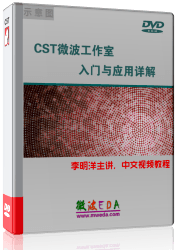Eigenmode Solver Specials (Tetrahedral)
 Solver
Solver  Start Simulation Start Simulation  Eigenmode Solver Eigenmode Solver  Specials Specials
Special solver controls frame
Accuracy:
Enter a value for the desired solver accuracy in terms of the eigensystem's
relative residual.
Consider static
modes: If the box is checked then the static modes are saved and
can be accessed via the result tree. Otherwise the static modes are not
saved.
Calculate thermal
losses: This setting allows to activate or deactivate the surface
loss calculation for the thermal coupling.
Solver order frame:
Allows to specify whether the Eigenmode solver
with tetrahedral mesh uses a first, second or third order method. Second
order is the default. If the structure is geometrically complex, first-order
is an alternative. Higher order allows to achieve accurate results with
less mesh cells and possibly less memory consumption than lower order,
if the structure contains electrically large voids rather than many geometric
details. For a given mesh resolution, higher order will provide even more
accurate results.
Curvature...
It is recommended to increase the curved element order, which is a property
of the mesh, if the solver order is increased. The button directly opens
the special tetrahedral
mesh properties where the Curved
element order can be changed.
Materials frame
Evaluation
frequency: These settings apply to the eigenmode solver with tetrahedral
mesh and to the eigenmode solver with hexahedral mesh and the JD method,
if Consider losses in postprocessing
only is deactivated in the Eigenmode
Solver Parameters dialog.
Electrically or magnetically conductive materials
and dispersive materials are evaluated either at the Center
frequency, or at some Other frequency.
This yields a complex permittivity and reluctivity which is assumed to
be frequency independent, as shown in the Eigenmode
Solver Overview.
Constant fit
and dispersion fit as in Time Domain: Check this box to consider
the fit procedure of the tangent delta settings in the Material
Parameter Conductivity Dialog using a dispersive Debye model correspondent
to the time domain. By deactivating this button the constant fit option
is realized as a constant tangent delta over the complete frequency range
while a dispersive fit results in a linear interpolation between the defined
loss angle values. The setting also affects the treatment of dispersive
materials if the model
simplification is configured so that lossy materials are treated as
lossfree.
OK
Accepts the changes and closes the dialog.
Cancel
Closes this dialog box without performing any
further action.
Help
Shows this help text.
See also
Eigenmode
Solver Overview, Eigenmode Solver,
Eigenmode Solver
Settings




HFSS视频教程
ADS视频教程
CST视频教程
Ansoft Designer 中文教程
|